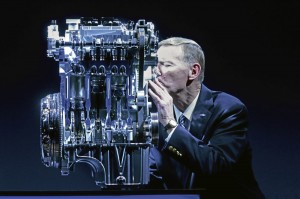The incredible shrinking engines

FORD Motor Co. president and CEO Allan Mulally kisses the Ford EcoBoost engine at a marketing event.
The snarl of a BMW V10 engine as it approaches 8000 rpm, as well as the punch to the gut that it delivers as it sends the M5 into hyperspace, is something you won’t soon forget. But it is something that is already part of history, as BMW is no longer building this engine for production cars. Instead, the new M5 is powered by a smaller-displacement 4.4-liter V8, from the previous 5.0 liters. Yet by no means is the new M5 a pipsqueak. The V8 delivers 560 hp (10 percent more power), 680 Nm (30 percent more torque at a lower rpm), and yet consumes 30 percent less fuel.
Welcome to the new reality of performance: engines that have shrunk in terms of displacement, but are just as powerful and much more efficient and environment-friendly. These days, when fuel prices are approaching record highs, a more fuel-efficient engine is a huge competitive advantage, even where performance cars are concerned. Emissions regulations are also encouraging manufacturers to develop smaller engines.
The secret to overcoming the limitations of a small swept volume: turbocharging. Diesel engines have been enjoying the benefits of turbocharging-power, torque, reduced emissions and consumption-for a few model generations. Turbo gasoline engines were popular for sports cars in the 1980 and 1990s but suffered from emissions and durability concerns. Now, thanks to new materials and designs, and computerized fuel metering, it’s the turn of gasoline engines to make the leap to turbocharging.
Simply put, turbocharging forces air into the engine intake, using the exhaust gas to spin an air pump. This pressurized intake air allows the engine to burn more fuel and increase its output. It saves on fuel because the engine only burns more fuel when needed. The rest of the time, during idling or cruising, for example, it can behave like a normal small-displacement engine. Applications range from ordinary commuter cars to sporty hatchbacks to super sedans.
Ford is poised to introduce small-displacement turbocharged engines in its entire lineup. The Explorer EcoBoost, set to debut at the Manila International Auto Show on March 29, will be the first to be so equipped. Taking the place of the 3.5-liter V6 engine in the Explorer Limited will be a 2.0-liter four-cylinder engine. With 240 hp and 366 Nm of torque, it puts to rest the notion that a mere 2.0-liter would be inadequate for the hulking Explorer chassis. Other Blue Oval nameplates will also pack blown engines. The Fiesta and EcoSport, built off the Fiesta platform, will have available 1.0-liter engines, and the next-generation Escape will have a 1.6-liter EcoBoost option.
The Mini Cooper brand has traditionally used small engines, and until today its largest engine is a 1.6-liter inline-four. Turbocharging on the S variant ups the power from 120 hp to 184 hp, and the John Cooper Works pumps that even further, to 211 hp.
BMWs used to have very clear nomenclatures: first digit-series number, second and third digits-engine displacement. Lately, though, the straightforward engine displacement has become a displacement-equivalent designation. Thus, a 740i will have a 3.0 liter engine, while a 750i packs a 4.4-liter V8. The twin-turbo 3.0 liter inline-six delivers the power packed by the previous 4.0-liter V8, while the 4.4-liter V8 is equivalent to the previous-generation V12. The V8 may not be as sublime as the twelve-cylinder, but it does deliver the desired performance with less weight.
Although BMW is most famous for its inline-six, the trend is for it to go four or even three cylinders.
Meanwhile, archrival Mercedes-Benz has launched its flagship S-Class with four-cylinder power, while Volvo Philippines has launched an S80 that uses a 1.6-liter turbo four for good measure. Range Rover’s new Evoque is likewise powered by a 2.0-liter turbo inline-four, appropriate for the sporty wagon’s lightweight chassis.
Even Formula One has not been immune to the shrinking engine trend. From the glorious V12s and V10s of the 1990s to smaller V8s of the present day, the pinnacle of motorsport has been running smaller and smaller engines. Thanks to turbocharging and the stratospheric 19,000 rpm capability, F1 engines are as powerful as they have been during the normally aspirated era. A move to even smaller V6 or four-cylinder power is being mulled. Again, this shouldn’t detract from racing, as some of the most powerful cars in F1 history were the 1000-plus hp turbocharged four-cylinders.
There are some drawbacks to turbos—primarily, potentially higher repair costs if engine components go bust. Some turbo engines require high-octane fuel to run properly. Then there’s the issue of engine sound. S-Class and Volvo owners won’t mind this at all, but the M5 driver definitely will miss the pulse-quickening sound of a race-bred engine. The same concern about a quieter—and thus less entertaining—engine is hobbling F1’s move to inline-fours. BMW’s solution: digitally pipe additional performance-engine sound effects through the M5’s stereo speakers. Purists may cringe, but that’s the only way you can hear your cake and eat it, too.
